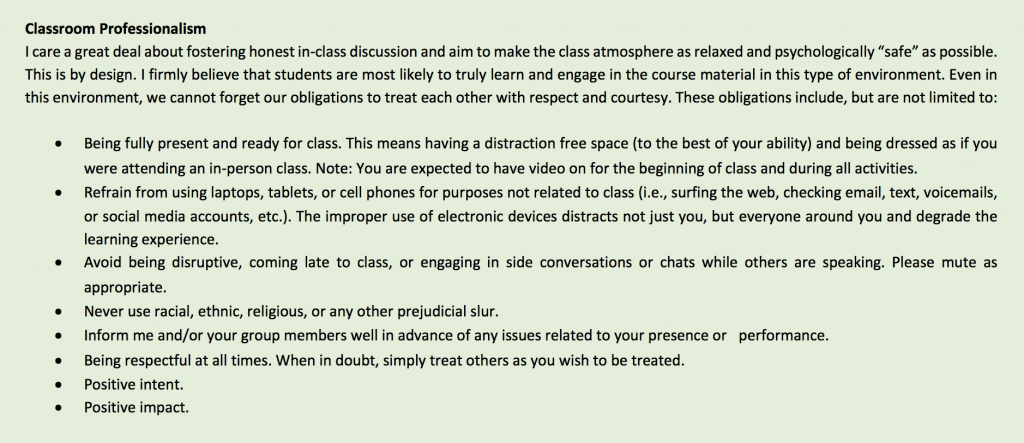In the last article, I gave 8 tips for building community and engagement in your online classes:
#1 – Camera On
#2 – Ice-Breakers
#3 – Breakout Rooms
#4 – Polling
#5 – Chat
#6 – Reactions
#7 – Annotations
#8 – Breaks
A lot of my tips were around creating engagement. How do you continue to build community?
Setting the Class Tone. At the beginning of each semester, we review the syllabus. I read aloud class expectations around respect, professionalism, and communication. The guiding principles below set the tone for interactions and expectations in and out of the “classroom,”—online, offline, in discussions, chats, assignments, projects, and other exchanges. Whether a class is synchronous, asynchronous, or a hybrid, setting expectations early helps both faculty and students.
I have chosen to include the following in my syllabus:

Excerpt from syllabus
Practice. In August, I spent ~45 minutes making sure we all knew how to use Canvas and Zoom. We practiced turning on our cameras and unmuting. We walked through reactions, chat emojis, and annotating. We even practiced changing our names (great hack when putting folks into breakout rooms – this was before participants could self-select their breakout rooms). We walked through how to enter and exit breakout rooms and how to ask for help.
Why is this so important? Practice makes perfect. This sets the foundation for the rest of the semester. It helps ensure students start with the same basic Zoom knowledge.
Setting the Technology Tone. Taking 45 minutes out of a class can seem daunting or a waste of time; however, every class after has gone smoothly. I imagine as students (and faculty) become more fluent in Zoom, this 45-minute Day 1 activity will only take 10 minutes in future semesters, and maybe even <5 minutes. This helps set the tone for class as well as expectations. I tell my students, “This is a HIGHLY interactive class. And if you want to breeze through or prefer asynchronous, please look for another class.” I mean that with the utmost respect.
If a student can do the dishes or clean their room while in a class – it may be better to pre-record content instead of having a live session.
Participation. Professors often joke, if you give students points, they will show up! Whether that’s through assignments, in class activities, homework, quizzes, exams, or even (the hotly debated topic of) extra credit. Simply showing up to class is easier now than ever – sign in, mute, turn off camera, and watch a show… Aside from points, how do we ensure our students are present, active, and participating?
Check-In. I run an icebreaker with the entire class with cameras on (I use chat for students with bandwidth/mic challenges). This is not just for me to check-in with each student. They get to learn about each other too. They learn how to present and be present.

Check-in Hacks
It’s 2020. We are all being asked to do more than we anticipated – I don’t have time to check in with every student every class – this allows me to do a quick pulse check.
Breakout Rooms. If I do not have time for a whole class check-in, I put students into random breakout rooms with 3-4 students, and they chat freely. How are you? What did you do for the long weekend? Sometimes I will give them a prompt based on their homework or a recent event. This can be 2-5 minutes. Some faculty open rooms up before class. I usually open breakout rooms during breaks – simulating casual, impromptu chats that would have happened organically during class breaks or transitions.
Aside from group projects and assignments, I use breakout rooms as a tool to increase engagement. If students are too quiet or not as responsive to lecture materials or questions, I throw out a question to the class, have them individually brainstorm ideas, and then have them discuss answers in small groups. They come back after 2-3 minutes and offer their answers, ideas, or suggestions via chat or unmuting. This usually increases the class energy too.
All of these small interactions add up and increase engagement and sense of community. Students get to know each other.
Discussion Boards. SJSU has a great resource list on how to use discussion boards. In addition to these ideas, I encourage students to share ideas, questions, events, and free resources on specific discussion threads. Having a dedicated space for questions and sharing of information supports collaboration and accountability. It also gives them a space to interact about non-class topics.
Group Activities. Lastly, I have group activities. Some are low-risk, easy point activities. Others are part of the formal semester long group project. More on this later!
These are all activities and ways which I foster a classroom community, on and offline. If you have any questions or want to brainstorm classroom community ideas, send me an email at allyson.gomez@sjsu.edu. Thank you. Stay safe.